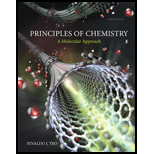
(a)
Interpretation:
The electronic configuration and orbital diagram for cobalt ion is to be stated. The cobalt ion is to be categorized as diamagnetic or paramagnetic.
Concept introduction: The electronic configuration determines the number of electrons present in each subshell of the element.
The orbital diagram is a representation in which, the orbitals are represented as the boxes containing the electrons with the opposite spin as the arrow facing upward and downward directions. The orbitals of the same subshell are attached with each other.
A substance exhibits paramagnetism if it possesses unpaired electrons. A substance exhibits diamagnetism if it possesses all spin paired electrons.
(b)
Interpretation:
The electronic configuration and orbital diagram for nitrogen ion is to be stated. The nitrogen ion is to be categorized as diamagnetic or paramagnetic.
Concept introduction: The electronic configuration determines the number of electrons present in each subshell of the element.
The orbital diagram is a representation in which, the orbitals are represented as the boxes containing the electrons with the opposite spin as the arrow facing upward and downward directions. The orbitals of the same subshell are attached with each other.
A substance exhibits paramagnetism if it possesses unpaired electrons. A substance exhibits diamagnetism if it possesses all spin paired electrons.
(c)
Interpretation:
The electronic configuration and orbital diagram for calcium ion is to be stated. The calcium ion is to be categorized as diamagnetic or paramagnetic.
Concept introduction: The electronic configuration determines the number of electrons present in each subshell of the element.
The orbital diagram is a representation in which, the orbitals are represented as the boxes containing the electrons with the opposite spin as the arrow facing upward and downward directions. The orbitals of the same subshell are attached with each other.
A substance exhibits paramagnetism if it possesses unpaired electrons. A substance exhibits diamagnetism if it possesses all spin paired electrons.
Want to see the full answer?
Check out a sample textbook solution
Chapter 8 Solutions
Principles of Chemistry: A Molecular Approach (3rd Edition)
 ChemistryChemistryISBN:9781305957404Author:Steven S. Zumdahl, Susan A. Zumdahl, Donald J. DeCostePublisher:Cengage Learning
ChemistryChemistryISBN:9781305957404Author:Steven S. Zumdahl, Susan A. Zumdahl, Donald J. DeCostePublisher:Cengage Learning ChemistryChemistryISBN:9781259911156Author:Raymond Chang Dr., Jason Overby ProfessorPublisher:McGraw-Hill Education
ChemistryChemistryISBN:9781259911156Author:Raymond Chang Dr., Jason Overby ProfessorPublisher:McGraw-Hill Education Principles of Instrumental AnalysisChemistryISBN:9781305577213Author:Douglas A. Skoog, F. James Holler, Stanley R. CrouchPublisher:Cengage Learning
Principles of Instrumental AnalysisChemistryISBN:9781305577213Author:Douglas A. Skoog, F. James Holler, Stanley R. CrouchPublisher:Cengage Learning Organic ChemistryChemistryISBN:9780078021558Author:Janice Gorzynski Smith Dr.Publisher:McGraw-Hill Education
Organic ChemistryChemistryISBN:9780078021558Author:Janice Gorzynski Smith Dr.Publisher:McGraw-Hill Education Chemistry: Principles and ReactionsChemistryISBN:9781305079373Author:William L. Masterton, Cecile N. HurleyPublisher:Cengage Learning
Chemistry: Principles and ReactionsChemistryISBN:9781305079373Author:William L. Masterton, Cecile N. HurleyPublisher:Cengage Learning Elementary Principles of Chemical Processes, Bind...ChemistryISBN:9781118431221Author:Richard M. Felder, Ronald W. Rousseau, Lisa G. BullardPublisher:WILEY
Elementary Principles of Chemical Processes, Bind...ChemistryISBN:9781118431221Author:Richard M. Felder, Ronald W. Rousseau, Lisa G. BullardPublisher:WILEY





